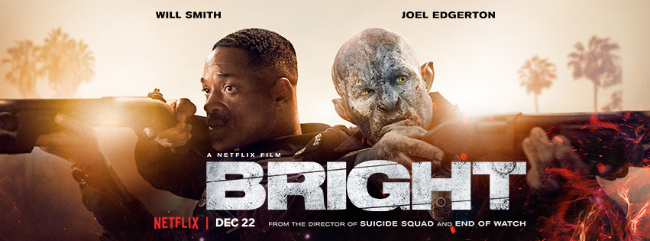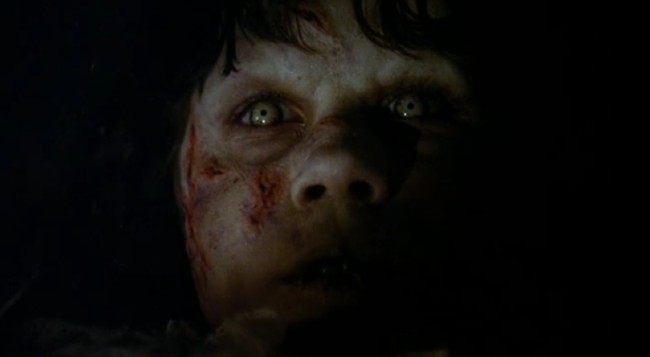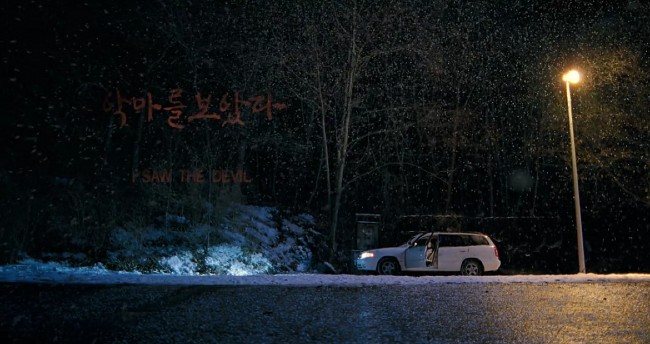The Cinema of Revenge

Revenge is dish best served cold…with a lot of hot lead.
Revenge. It’s an act as old as the bible. Cinema, from the begining of the medium, has explored the theme of revenge. Whether revenge is played for comedic effect as in The First Wives Club (1996), or part of a life and death struggle like in The Revenant (2015), or when the system is failing like in The Brave One (2007) it’s always a dish served cold.
Upgrade (Spoilers ahead)
Blumhouse, known for its releases of the Insidious movies and the more recent Academy Award nominated Get Out, has had some misses, but for every miss the production company has had its had just as many successes. Upgrade, the company’s first foray into science fiction, is one of those success.
Set in the distant but familiar future, Grey Trace (Logan Marshall-Green, a less beefy looking Tom Hardy) is the last of the gas engine mechanics. Of course, being a mechanic he’s adverse to most technological advances, like self-driving cars. However, this does not stop him from having a wife knee deep in the tech trenches.
A revenge movie isn’t a revenge movie if there’s nothing or no one to seek revenge against. Upgrade begins when Trace and his wife Asha’s (Melanie Vallejo) self driving car goes haywire and crashes into the worst part of town. Waiting outside the crashed car are armed men ready to cause the couple harm. Trace is left crippled from the neck down and Asha is murdered.
Upgrade stumbles with cliches during the first half of the movie. It’s not until later we find out the reason behind the couple’s car going haywire, but for much the film it goes unaddressed. We can only assume it’s another case of a car breaking down in the worst place in town cliche. Why? Because there wouldn’t be a story if the car broke down in the suburbs. After Trace has been diagnosed as a paraplegic he’s approached by tech genius Eron Keen to be a guinea pig for his new STEM invention. The idea of walking again and having the use of his arms isn’t enough for Trace to accept the offer. So Keen drops the tried, trued, and cliched “What would she (his murdered wife) want?” Of course, the next scene we see Trace undergoing surgery. After the surgery no named doctors tell Trace and Keen not to expect immediate results. Shocker of shockers there’s immediate results.
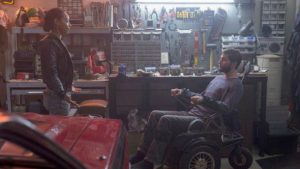
Once the cliches are out of the way, Upgrade takes off. One of the reasons Upgrade succeeds is Marshall-Green’s performance. It turns out STEM is an AI chip that takes control of Trace’s body. The challenge for Marshall-Green was to act like something is controlling his body without his performance coming off as someone acting like he has no control over his own body. It’s a feat he pulls off with scary effect.
The fight scenes are some of the best put on film in ages. Thankfully, these scenes aren’t over edited and chopped up like all the fight scenes in Marvel movies. When will Hollywood directors take a cue from some of the great karate movies- leave the camera alone, let the fight play out. How many edits on top of edits in a Bruce Lee movie have you seen? Exactly.
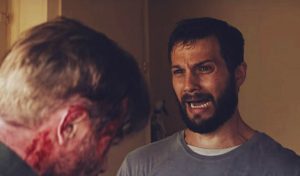
Fight scenes and revenge killing scenes aside, even though they’re pretty darn cool, Upgrade also succeeds because it’s probably one of the only revenge movies where the protagonist doesn’t want revenge. Yes, Trace wants revenge and he even gets some payback, but he never gave himself completely over to the idea of revenge. It’s too late when he learns STEM has taken over his body to continue where Trace left off.
The ending you think is coming during the final showdown doesn’t materialize. Whether you saw the ending coming or not it’s nice to see a movie end in a non-Hollywood way. Trace may have gotten his revenge against the thugs who murdered his wife, but at what price?
Revenge
Revenge, as the title implies, is a movie about revenge. More importantly, it’s a movie about good old fashion payback. Jen, portrayed as a typical sexy young woman with the lack of clothing to match, is raped by her boyfriend’s hunting partner. Things don’t seem like there going to go Jen’s way after Jason, the boyfriend, pushes her off a cliff and she’s impaled on the only tree for miles. So it would seem.
Coralie Fargeat’s Revenge can be viewed as an another entry in the rape/revenge films started with the original I Spit On Your Grave (1978). Revenge is also a fantasy film. Most revenge movies do involve a certain amount of fantasy and who could blame the director or screenwriter for wanting to extract a little revenge? At some point in our lives most of us have wanted to get some kind of revenge. However, most of us do not act on our impulses and those unfortunate enough to have faced great trauma must wait to find justice in a courtroom, if they find justice at all.

You can tell from the beginning Revenge separates itself from the other rape revenge movies. The first thing you will notice is the color palette and lighting choices Fargeat and cinematographer Robrecht Heyvaert use in the film. Instead of dark colors and shadows, Fargeat and Heyvaert have chosen to use bright colors throughout the film. The colors and lights pop off the screen. It’s safe to say Revenge with its quick cuts and a peyote trip thrown in for good measure is unlike the rest of the movies in this sub-genre.
You can’t ignore the fact Jen, and by proxy actress Matilda Anna Ingrid Lutz, is stunningly beautiful. Most directors would be tempted to play up her sexuality throughout the movie. A lesser director would highlight and draw attention to her assets over the brutal payback she’s exacting against her attackers. Fargeat doesn’t shy away from the fact her leading actress is gorgeous nor does she try to cover her beauty. In fact, as the film moves closer to the end the less clothes Jen is wearing. In one particular scene the camera zooms in on her tight shorts. You would have to be blind not to notice the bottom half of her buttocks hanging out of her shorts.

To some the lack of clothing on an attractive woman may be a cause for celebration. Except you won’t even notice Jen’s tight shorts or skimpy top. As Jen’s clothes become skimpier her revenge gets more brutal and Fargeat clothes her in blood and guts. It’s so far from sexy you’ll find yourself concentrating more on Jen’s transformation than her skin. By the end of the movie she is unrecognizable as the hot blonde sucking on a lollipop we first meet. By the end of the movie Jen has been transformed like the phoenix (although I would like to think it’s an Aztec war bird) on the beer can she uses to sear her wound closed. The Barbie Doll has been replaced by a killer.
Is Revenge the first revenge movie in the Time’s Up era? Only the viewer can decide. However, the answer to that question may depend on how you would answer Jason when he says, “Women always have to put up a fucking fight.”
(But what’s with all the ants in the movie? Recent studies show even ants get a little revenge now and then)
Death Wish
Hollywood loves remaking classic movies. The original Death Wish, starring Charles Bronson, spawned four sequels before Bronson ran out of thugs to kill on the big screen. So it was only natural Hollywood would pull the franchise out of the mouth balls.
Quentin Tarantino acolyte Eli Roth helms this unremarkable remake. The first question is why would a movie be released about vigilante killing in the middle of one the United State’s biggest gun debates and a month after the shooting at Marjory Stoneman Douglas High School?
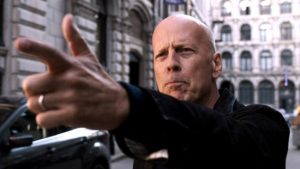
Production and release dates have been pushed back before in the wake of tragic events. Sam Raimi’s Spider-Man was delayed because it had one brief scene with the Twin Towers in the shot. An episode of the popular Mr. Robot was delayed because the episode was too similar to a reporter who had been shot on camera days before the episode was to air. Even the Ben Stiller comedy Neighborhood Watch didn’t escape being affected by the Trayvon Martin shooting. So, it was possible for the studio to delay the release of the movie.
The studio and Roth had a chance to at least do something different with the overall premise and theme of Death Wish. However, they didn’t. Instead they cast Bruce Willis as a doctor and a father whose wife is murdered and his daughter is left in a coma after a violent attack in there home.
The point of these movies is that we have to believe the lead actor or actress has been a victim. Willis doesn’t come off as a victim or even someone grieving the loss of his wife. Willis never delivers on the role of victim or as a victim who stops being a victim and takes things into his own hands. His performance comes off as insincere.

Besides Willis’s stale acting he comes with a lot of action hero baggage. How many movies have we seen Willis plow through armed bad guys with machine guns, handguns, and hand grenades? That’s a rhetorical question. The answer is a lot. The combination of stale acting an action movie pedigree makes it difficult to believe Willis was ever a victim fighting for his family when the police did nothing.
If we can’t believe the performance the movie falls apart. For example, we believe Kevin Bacon in Death Sentence because he came off as vulnerable, a fish out of water who has bitten off more than he can chew when he goes after the gang who murdered his son. Death Sentence succeeds on the acting of Bacon while Death Wish fails on the acting of Willis.
The second question about Death Wish is what kind of message the movie is sending? Although Detective Raines (Dean Norris, Breaking Bad) says some off color comments about killing homeless people he seems genuine in wanting to solve Willis’s string of vigilante killings. As it turns out, and you would never have put it together from the evidence presented on screen, Raines doesn’t care who is killing criminals in the city. Basically, the moral of Death Wish is you can kill a lot of people and get away with it if the detective in charge doesn’t really care about due process under the law.
Hollywood, in the future if you’re going to remake a movie like Death Wish, which you will, try casting against type. How different would Death Wish been if an actor like Hamish Linklater (Legion) or Justin Long (Tusk, Jeepers Creepers) were cast in the lead role? Totally different and in a good way. Also, if you’re going to make a movie like this make sure the audience knows the repercussions of the actions.

Nietzsche said, pardon the slight paraphrasing, be careful when hunting monsters you don’t turn into a monster yourself. The point is you may turn into the same thing you’re trying to destroy. Even if you don’t turn into a monster yourself you may still find revenge once sated may not be as sweet as you. imagined.



